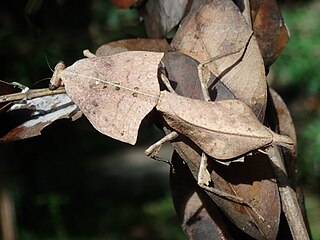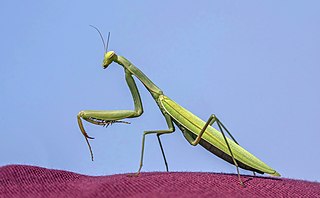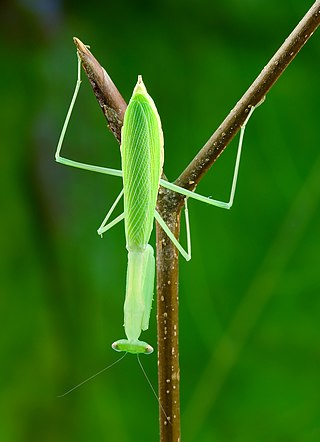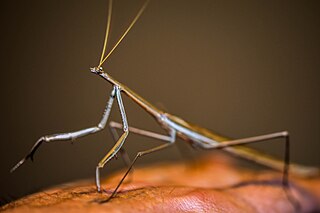
Mantidae is one of the largest families in the order of praying mantises, based on the type species Mantis religiosa; however, most genera are tropical or subtropical. Historically, this was the only family in the order, and many references still use the term "mantid" to refer to any mantis. Technically, however, "mantid" refers only to members of the family Mantidae, and not the 14 remaining families of mantises. Some of the most recent classifications have promoted a number of the mantid subfamilies to the rank of family, e.g. Iridopterygidae, Sibyllidae, Tarachodidae, Thespidae, and Toxoderidae, while other classifications have reduced the number of subfamilies without elevating them to higher rank.

Metallyticus is a genus of praying mantis. It is the only genus in the monotypic family Metallyticidae. They are mostly found in South-East Asia. The species of the genus are dark, somewhat flattened and cockroach-like, and often with a cuticle that is reflective and metallic in appearance.

Mantoida is a genus of praying mantises in the family Mantoididae. The species of this genus are native to Mexico, Central America, and South America.

Eremiaphilidae is a small Old World family of praying mantids, based on the type genus Eremiaphila. As part of a major revision of mantid taxonomy, this family now contains the subfamily Tarachodinae, which includes tribes and genera previously placed in the now obsolete Tarachodidae.

Liturgusidae is a family of praying mantises in the new (2019) Neotropical superfamily Acanthopoidea. A substantial number of genera, previously placed here, have recently been moved to the new or revived other families:
Parablepharis is a genus of praying mantises in the family Hymenopodidae. It is monotypic, being represented by the single species, Parablepharis kuhlii and is found in India, Myanmar, Vietnam, Borneo, Java and Yunnan, China.
Titanodula fruhstorferi is a praying mantis species in the subfamily Hierodulinae.
Hierodula tonkinensis is a praying mantis species in the tribe Paramantini.

Deroplatys gorochovi is a species of praying mantis in the subfamily Deroplatyinae and the new (2019) family Deroplatyidae.

Iridopterygidae was a family of praying mantids in the order Mantodea whose members, having formerly been moved here as a subfamily within Mantidae, have now been transferred elsewhere as part of the recent (2019) major revision of mantid taxonomy.

Mantises are an order (Mantodea) of insects that contains over 2,400 species in about 460 genera in 33 families. The largest family is the Mantidae ("mantids"). Mantises are distributed worldwide in temperate and tropical habitats. They have triangular heads with bulging eyes supported on flexible necks. Their elongated bodies may or may not have wings, but all Mantodea have forelegs that are greatly enlarged and adapted for catching and gripping prey; their upright posture, while remaining stationary with forearms folded, has led to the common name praying mantis.

Miomantidae is a family of praying mantises in the order Mantodea.
Tricondylomimus is an Asian genus of praying mantis in the family Gonypetidae. Formerly considered as a junior synonym of the genus Nemotha, Chopard's original genus name was restored in 2017. The name is for the similarity to tiger beetles in the genus Tricondyla contributed by the pronotal shape and color.

Chlorocalis is a genus of praying mantids in the family Mantidae, now placed in the tribe Hierodulini. Species can be found in the Indo-China region.
Phasmomantella is a genus of praying mantids placed in the tribe Euchomenellini and family Deroplatyidae. The two known species appear to be endemic to Vietnam.

The Hierodulinae are a subfamily of praying mantids, originally used by Brunner von Wattenwyl. It was restored as part of a major revision of mantid taxonomy, and now contains genera previously placed elsewhere in the family Mantidae.

The Leptomantellidae are a new (2019), small family of praying mantids, based on the type genus Leptomantella. As part of a major revision of mantid taxonomy, genera have been moved here from the Caliridinae in the now obsolete family Tarachodidae.

Hoplocoryphidae is a newly erected (2019) family of praying mantids, based on the type genus Hoplocorypha. As part of a major revision of mantid taxonomy, genera have been moved here from the subfamily Hoplocoryphinae of the previously polyphyletic family Thespidae. The family Hoplocoryphidae is the only member of superfamily Hoplocoryphoidea. Species in this family have been recorded from tropical Africa.

Eomantis guttatipennis is a species of praying mantis in the family Nanomantidae. It is the type species of the genus Eomantis, having previously been placed in Tropidomantis. This species has been recorded from India, Nepal, Tibet, Myanmar and Vietnam.

Chlorocalis maternaschulzei is a species of praying mantis in the family Mantidae and tribe Hierodulini. Records of this species are from the seasonal tropical forests of Thailand and Vietnam; the type specimen is from Nakhon Ratchasima Province.













